Circle of Harvest
The Circle of Harvest is an ancient ritual rooted in the agrarian traditions of early societies, particularly during the Neolithic era. This ceremonial practice was centered around celebrating and invoking the blessings of deities for a bountiful harvest. The ritual is characterized by its symbolic use of circular formations and offerings to express gratitude and ensure future fertility of the land.

Historical Context
The Circle of Harvest finds its origins in the earliest agricultural communities when human societies began transitioning from hunting and gathering to farming and settled living. As the success of crops became integral to survival, these communities developed rituals to venerate Earth Mother Deities and other spirits associated with fertility and abundance. The Neolithic Celebrations were pivotal in reinforcing these practices, with the Circle of Harvest being one of the most revered ceremonies.
Ritual Structure
Formation and Dance
At the heart of the Circle of Harvest is the formation of participants into a circle, symbolizing unity and the cyclical nature of seasons. This circle represents the endless cycle of planting, growth, harvest, and rest. Dancers move rhythmically in a clockwise direction, often mimicking agricultural activities such as sowing seeds and reaping crops. The dance is accompanied by music from traditional instruments like flutes and drums, believed to resonate with the vibrations of the earth.
Offerings and Symbols
Central to the circle is an altar, lavishly decorated with the first fruits of the season, grains, and flowers. These offerings serve as a tangible expression of gratitude to the deities. Symbols of fertility, such as spirals and concentric circles, are often inscribed on pottery and textiles used in the ceremony. These symbols are believed to harness the power of natural cycles and amplify the community's intentions for prosperity.
Cultural Significance
The Circle of Harvest is more than a mere ritual; it is a profound affirmation of the community’s relationship with the natural world. It reinforces social cohesion by bringing people together in a shared act of devotion and thanksgiving. This ritual also serves as an educational tool, passing down agricultural knowledge, spiritual beliefs, and cultural values to younger generations.
The sense of community and continuity found in the Circle of Harvest is mirrored in other rituals such as the Dance of the Earth Spirits, which similarly celebrates the connection between humans and the earth.
Modern Relevance
Today, the Circle of Harvest continues to be observed in various forms, often adapted to fit modern contexts. In some regions, it is integrated into contemporary festivals that celebrate agricultural heritage and environmental awareness. These modern adaptations maintain the core themes of gratitude and respect for nature, while also incorporating new artistic expressions.
The ongoing practice of the Circle of Harvest and similar rituals like the Stone Circle Festival highlights the enduring significance of these ancient traditions in fostering community identity and ecological mindfulness.
See Also
- Neolithic Celebrations
- Earth Mother Deities
- Dance of the Earth Spirits
- Stone Circle Festival
The Circle of Harvest remains a powerful emblem of humanity's deep-rooted connection to the earth and the cycles that sustain life. It embodies the timeless values of gratitude, community, and the harmonious balance between humans and nature.